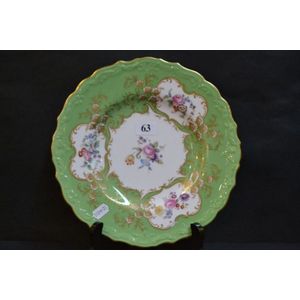Limited Edition Bird Dessert Plates by Royal Worcester
You must be a subscriber, and be logged in to view price and dealer details.
Subscribe Now to view actual auction price for this item
When you subscribe, you have the option of setting the currency in which to display prices to $Au, $US, $NZ or Stg.
- Bone China - Bone china, Also called 'English china", is one of the three types of porcelain, the other two being soft paste porcelain and hard paste porcelain.
Porcelain is an ancient ceramic material, first made in China, hence the common name "china", and the introduction of bone china was to counter the imports of Chinese porcelain.
The initial development of bone china is credited to Josiah Spode, who introduced it around 1800 and it was soon after copied by other manufacturers including Minton, Coalport, Davenport, Derby, Worcester, Wedgwood and Rockingham and the Herculaneum factory at Liverpool.
Spode's bone china was made by mixing ash from cattle bones with feldspar and kaolin, which created a material that was stronger, more translucent, and whiter than traditional porcelain. He began to produce this new type of porcelain in 1796 and it quickly became very popular.
At the time, the process and ingredients were kept secret and were only known to a few manufacturers and were protected by patents.
In the 19th century, bone china became increasingly popular and was widely produced by many manufacturers in England. During this time, it was considered a luxury item and was often used to create fine dining sets and other decorative items.
Bone china is still used in the production of fine porcelain wares, such as tea sets, figurines, and other decorative pieces. His basic formula of six parts bone ash, four parts china stone, and three and a half parts china clay remains the standard English body. It is still considered a luxury item due to its strength, translucency, and whiteness, and is often used for high-end and high-quality porcelain. China. - Verso - Verso is the "back" side of a sheet of paper, art work, coin or medal. The front side is "recto".
This item has been included into following indexes:
- Doughty, Dorothy & Freda - Royal Worcester artists 63
- Royal Worcester (England), item types
Visually similar items

A rare Longton hall moulded strawberry leaf and fruit plate, circa 1751-60, Stoke on Trent, in soft paste porcelain, the leafy border softly decorated in apple green, emerald colours and magenta highlights, with 'Deutsche Blumen' posies and sprigs to the b

Spode Copeland plate, green ground

An antique Chinese famille rose export ware plate, the lobed pale celadon plate decorated in the European manner with Deutsche Blumen in a puce, purple, and deep yellow palette, with viridian and apple green foliage, diameter 22.5 cm

A small bow porcelain works plate, 1760-1776 period, the lobed plate with a gilt dentil border, scattered with Deutsche Blumen, diameter 17.5 cm
